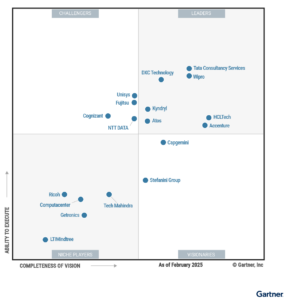The outsourced digital workplace services (ODWS) market is rapidly evolving as clients seek enhanced workplace experiences, innovation and value-driven solutions from service providers. In response to these shifting demands, Gartner conducted a comprehensive evaluation of 18 prominent ODWS vendors to guide IT sourcing leaders in selecting partners aligned with their strategic objectives. Seven of these companies made it onto the leaders quadrant of the Magic Quadrant. This quadrant consists of vendors who have proven their ability to execute and vision completeness.
ODWS encompasses a broad range of services, which spans consulting, implementation and support—designed to empower end users who rely on digital tools and devices to perform business tasks efficiently. This dynamic market emphasizes integrated digital workplace services that boost productivity, engagement, and adaptability, reinforcing their critical role in today’s business strategies.
Tata Consultancy Services: Cognix
TCS is headquartered in India and has about 650 ODWS clients. It focuses on large enterprises in a variety of industries.
Strengths: Value-driven Solutions, Talent Management & Technology Integration Platform
Gartner recognized Tata Consultancy Services(TCS) as a leader in Outsourced Digital Workplace Services for its holistic and value-driven solutions, which enable clients to co-create, test and scale next-generation ODWS solutions. Gartner honed in on TCS’s advanced technology integration platform, Cognix, which was later recognized for incorporating technologies like AI, DEX, automation and self-healing, enabling TCO reduction.
Weaknesses: MSE Offerings, Customer Experience & XLA Sentiment Measures
Gartner cautions MSE customers that customizing TCS’s packaged solutions can affect onboarding and cost. Customers have also had issues with service delivery, ongoing communication and deliverable and resource management quality. Additionally, TCS’ XLAs are founded on personas instead of measuring sentiment and user experience.
Wipro: AI LiVE Workspace
Headquartered in India, Wipro has 286 ODWS clients. It focuses primarily on large enterprise clients in the BFSI and healthcare industries.
Strengths: Mature XLA Framework, Reimagining LiVE Workspace, Co-solutioning Capabilities
Wipro enhances employee satisfaction and productivity by focusing on XLA-driven governance. The XLA themes are co-developed with customers, aligning them with the client’s goals.
Wipro has also enhanced its service portfolio with a reimagined LiVE Workplace. Wipro AI LiVE Workspace uses AI for operations, productivity, user empowerment and security.

Lastly, Wipro focuses on impactful employee journey engineering via Wipro Designit, which uses consulting and collaborative workshops to co-create user journeys, personas and workflows with the client. Its Delivery Maturity Index framework also quantifies service delivery maturity with best practices, performance insights and process and quality improvements.
Weaknesses: MSE Fit, Attrition Rates & Contractual Flexibility
If you are an MSE, Wipro probably isn’t a fit. While Wipro didn’t disclose its MSE client percentage to Gartner, its price tag and inflexible solutions make it a less desirable option for enterprises with under $1 billion in revenue.
The workforce attrition rate is higher than the average at 14.8%. Additionally, it’s increasing quarter over quarter, potentially disrupting Wipro’s operations. Gartner suggests that clients seeking delivery consistency include contractual commitments or penalties for any disruptions caused by attrition.
Wipro also struggles with delivery quality. Clients have cited that Wipro is reluctant to exceed contract terms. In response, Gartner suggests ODWS clients ensure their contracts with Wipro address all expectations for innovation, flexibility and continuous improvement.
DXC Technology: DXC UPtime
Headquartered in the U.S., DXC Technology(DXC) consists of an estimated 716 ODWS clients. The primary focus for DXC is Fortune 1500 companies with 10,000 or more employees.
Strengths: Experience Management, Operations & AI-driven Workplace Services
Experience management is one of the areas in which DXC excels. The company uses a tiered control framework, which offers a structured and scalable approach. Its XPI framework enables it to reach a granular level, which allows it to deploy and scale faster than custom solutions.
Operations recently experienced a reorganization, which focused on establishing global and regional teams to improve customer business goal delivery. Additionally, numerous global programs and partnerships help boost their new direction.
DXC’s UPtime Experience platform centralizes its AI-driven workplace services. The centralization allows the platform to provide automated and actionable solutions.
Weaknesses: Technology Centricity, ODWS Business Decline & Service/Offering Complexity
Where DXC’s experience management programs fall short is employee sentiment. It focuses on a tech-centric view of experience, which limits DEX alignment, technology adoption and customers’ business outcomes.
Additionally, revenue declined by 11.1% and the number of supported workers decreased by 5.2% during the assessment period of Gartner’s research. Lastly, DXC’s spread of solutions and capabilities makes it difficult for clients to determine what offerings are included, how they integrate and which are best for their industry.
Kyndryl: Kyndryl Bridge
Kyndryl is headquartered in the U.S. and has approximately 534 ODWS clients. It targets large enterprise players in the industrial, financial services and distribution industries.
Strengths: Platform Tools, XLA & Sustainability
Kyndryl was recognized as a leader in Digital Workplace Services for its Kyndryl Bridge platform development with tools around AI, GenAI, DEX and observability. This platform is also developing XLA to improve employee and workplace experience. Additionally, Kyndryl has sustainability solutions that help its clients align their business goals with ESG regulations.
Weaknesses: Inconsistent Messaging, ODWS Growth, Limited Support
Some areas to be aware of include Kyndryl’s inconsistent geographic messaging, Flat ODWS business growth and limited cloud DaaS/VDI support. Gartner suggests that global enterprise clients encourage closer collaboration between Kyndryl’s global and local teams. They also caution prospective clients to understand Kyndryl’s long-term financial growth plan for the ODWS business.
HCLTech’s Outcome-based Innovations
HCLTech’s headquarters are in India. The company has around 480 ODWS clients and delivers to organizations of all sizes in the manufacturing and financial services industries.
Strengths: Outcome-based Innovations, Large & Industry Solution Deployment
HCLTech has several outcome-based innovations. Additionally, HCLTech is among the largest ODWS providers with 10% YoY growth and 10% of its revenue put back into transformation, innovation and XLA model transition. Lastly, HCLTech provides unique manufacturing, healthcare, automotive and retail solutions.
Weaknesses: Lack of Sustainability Solution Differentiation, Contract Inflexibility, Misaligned XLA Definition
Some areas that HCLTech is lacking in include sustainability solution differentiation. While it has some IP for tracking environmental aspects of ESG, it doesn’t have social sustainability solutions.
Another area that potential clients should be aware of is their contract inflexibility. HCLTech has many innovative solutions for the workplace. However, if these solutions aren’t included in the customer contract, HCLTech will not offer innovative ideas or solutions.
The last area of concern was HCLTech’s misaligned XLA deployment and definition. While the primary intent was to measure experience metrics representing human-centric outcomes, their XLAs fail to include sentiment; instead, they rely on transactional metrics and NPS.
Atos: Experience Operations Center
Atos’s headquarters are in France. It has approximately 730 ODWS clients and is focused on delivering solutions to large enterprises in the healthcare and life sciences sectors.
Strengths: Evolving Experience Framework, Innovative Sustainability, Agile Co-Creation
Atos has some promising strengths, as Gartner pointed out. The first is the company’s steadily evolving experience framework, highlighting its commitment to client satisfaction. This year, they even launched an Experience Operations Center, which leverages real-time telemetry from sources like DEX.
Atos also invests in targeted innovative offerings like sustainability advisors who address critical human-centric environmental, social and governance dimensions. Lastly, Atos approaches deals through non-RFP methods, which demonstrates its focus on helping clients be involved in their solutions.
Weaknesses: Market Uncertainty, Inconsistent Automated Contact Resolution, Revenue Decline
One area to be aware of is uncertainty around Atos’ commitment to the digital workplace services because of its recent financial difficulties and 5.3% revenue decline. As a result, Gartner advises clients to monitor Atos to ensure the stabilization process continues. Gartner also found that Atos’ reports on contact resolution were inconsistent.
Accenture’s Comprehensive and Industry-Specific Solutions
Accenture is headquartered in Ireland and has 294 ODWS clients. It focuses on large and very large enterprises across a wide variety of industries.
Strengths: Comprehensive Industry-specific Solutions & Strong XLA Framework
Accenture excels in delivering a comprehensive list of industry-specific solutions with clear outcomes. Accenture can tailor these solutions to meet industry standards and anticipate future challenges and opportunities. It interconnects applications and infrastructure managed services, which boosts efficiency and innovation.
Accenture also has a strong XLA framework. It integrates KPIs into a balanced scorecard, which ensures accountability, alignment with client business processes and enhanced UX management.
Weaknesses: Pricing, Regional Strategy, Limited Modern Device Management
One of the areas where Accenture raises some eyebrows is pricing for services with pre-user costs and new image builds. Gartner advises interested parties to weigh the value versus the cost of Accenture’s complex contract structures.
Another area of concern is its regional strategy. Accenture allows each region to determine its market execution strategy, which could pose a problem for global clients.
Lastly, while Accenture does have an impressive list of solutions, its modern device management solutions are limited. Of the 10 million endpoints Accenture manages, only 6.3% are modern devices.
Related News:
Parallels Named Visionary in the 2024 Gartner Magic Quadrant for DaaS
ControlUp Named Leader in the 2024 Gartner Magic Quadrant for DEX Tools
More Endpoint News


